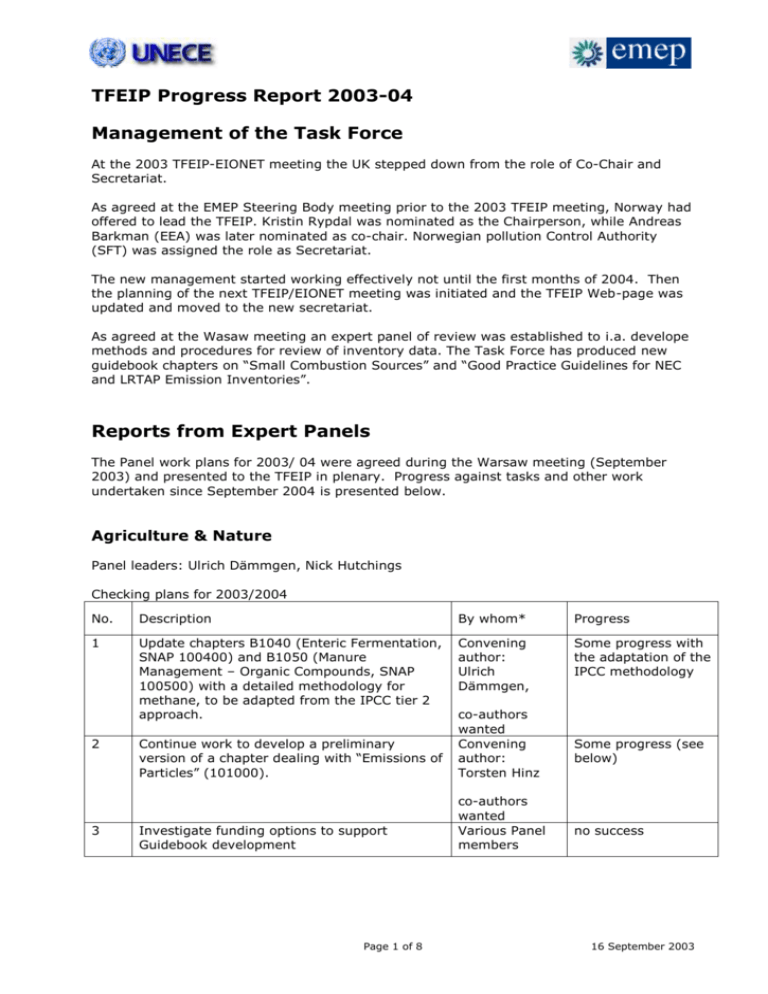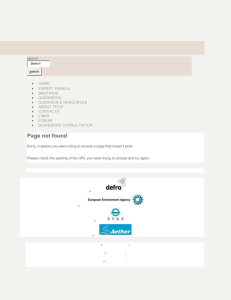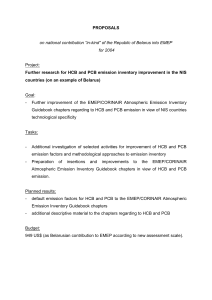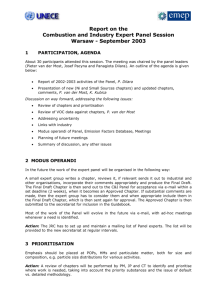Report on the Combustion and Industry Expert Panel
advertisement

TFEIP Progress Report 2003-04 Management of the Task Force At the 2003 TFEIP-EIONET meeting the UK stepped down from the role of Co-Chair and Secretariat. As agreed at the EMEP Steering Body meeting prior to the 2003 TFEIP meeting, Norway had offered to lead the TFEIP. Kristin Rypdal was nominated as the Chairperson, while Andreas Barkman (EEA) was later nominated as co-chair. Norwegian pollution Control Authority (SFT) was assigned the role as Secretariat. The new management started working effectively not until the first months of 2004. Then the planning of the next TFEIP/EIONET meeting was initiated and the TFEIP Web-page was updated and moved to the new secretariat. As agreed at the Wasaw meeting an expert panel of review was established to i.a. develope methods and procedures for review of inventory data. The Task Force has produced new guidebook chapters on “Small Combustion Sources” and “Good Practice Guidelines for NEC and LRTAP Emission Inventories”. Reports from Expert Panels The Panel work plans for 2003/ 04 were agreed during the Warsaw meeting (September 2003) and presented to the TFEIP in plenary. Progress against tasks and other work undertaken since September 2004 is presented below. Agriculture & Nature Panel leaders: Ulrich Dämmgen, Nick Hutchings Checking plans for 2003/2004 No. Description By whom* Progress 1 Update chapters B1040 (Enteric Fermentation, SNAP 100400) and B1050 (Manure Management – Organic Compounds, SNAP 100500) with a detailed methodology for methane, to be adapted from the IPCC tier 2 approach. Convening author: Ulrich Dämmgen, Some progress with the adaptation of the IPCC methodology 2 3 Continue work to develop a preliminary version of a chapter dealing with “Emissions of Particles” (101000). co-authors wanted Convening author: Torsten Hinz Investigate funding options to support Guidebook development co-authors wanted Various Panel members Page 1 of 8 Some progress (see below) no success 16 September 2003 Personal changes Hans Benny Rom, co-chair of the Panel, resigned. Nicholas John Hutchinson from the same institution (Department of Agricultural Systems, Danish Institute of Agricultural Sciences, PO Box 50, Research Centre Foulum, 8830 Tjele, Denmark) is his successor. Ammonia (1) A mid-term meeting was held in Poznan together with the Ammonia Abatement Group. Items discussed with respect to the Guidebook: consistent development of the mass flow approach comparison of various worksheets to harmonize calculations Guidebook chapters B1010, 1020, 1040, 1050 and 1090 will be amended and updated to include information reflecting the situation in the accession and the Mediterranean countries to allow for a higher resolution in time (months) Authors were identified; work has not started yet. (2) In order to assist countries with little experience in establishing an agricultural inventory according to the Guidebook, a comprehensive book on ammonia emissions and their inventories is being written and will be published in Poznan in 2005. (3) The EAGER group (European Agricultural Emissions Researchers, with participants from Denmark, Germany, Netherlands, Sweden, Switzerland and the UK) met at Wageningen (June 10 to 11) and will meet in Zuerich (November 25 to 26, 2004) to work on details of the mass flow approach and the national input figures (e.g. N excretion). (4) The updating of the IPCC guidelines will incorporate NH3 emissions into the calculations of emissions of N species. UD will be co-author of the respective chapter. PM emissions A PM meeting (with participants from Finland, Germany, Netherlands, UK) was held at The Hague, June 16/17. The results justify writing of a preliminary chapter on emissions from animal houses with forced ventilation. The lead authors and UD will provide a draft chapter before soon. It might be available at Ispra. No progress was made for any other particle emissions due to almost total lack of data. VOC emissions from forests The lead author (Rainer Steinbrecher) will arrange a meeting of the authors in December 2004 and update the present chapter 1101. Page 2 of 8 16 September 2003 Plans for 2004/2005 No. Description By whom* 1 Update chapters B1040 (Enteric Fermentation, SNAP 100400) and B1050 (Manure Management – Organic Compounds, SNAP 100500) with a detailed methodology for methane, to be adapted from the IPCC tier 2 approach. Continue work to develop a preliminary version of a chapter dealing with “Emissions of Particles” (101000). Step 1: Chapter on emissions from animal houses with forced ventilation Update chapter B1090 (Nitrogen species from manure management) Convening author: Ulrich Dämmgen, Update chapters B1010 and 1020 work likely to begin in spring 2005 2 3 4 Progress Convening author: Jens Seedorf, U. Dämmgen EAGER group members Combustion & Industry Panel leaders till October 2004: Panagiota Dilara, Jozef Pacyna, Pieter van der Most Panel leaders after October 2004: Knut Breivik, Panagiota Dilara, Carlo Trozzi Work Programme 2003-2004 (as decided at the Warsaw meeting) No. Description By whom By when Status 1 Complete the Small Combustion Sources Chapter JRC December 2003 Done 2 Complete the primary Ni Chapter PM 2004 In preparation 3 Identify other experts, including industry, inspectorates, research projects etc. who could participate in the work of the panel. JP, PD November 2003 Not done 4 Launch the Emission Factors Database for the Combustion and Industry Panel Organise first experts workshops in order to promote the DB JRC Mid 2004 Postponed JRC 1 month after launching the DB Postponed 5 Page 3 of 8 16 September 2003 6 To analyse the BREFs for Emission Factors CT End 2003 Not done 7 Prioritisation of chapters considering priority substances and detailed vs simple methodology Participate to the work of a task-group on PM PM, JP End 2003 Done JP continuing Done Re-write the solvents chapters CT, RdL By mid-2004 Postponed 8 9 The work plan agreed during the Warsaw meeting featured a number of key objectives to be achieved during 2003/04. The table above gives a summary of progress; each the specific objectives are summarised below. Items which were taken up during the year are also mentioned at the end. Detailed description of activities: 1. Complete the Small Combustion Sources Chapter The JRC has dedicated approximately 4 man-months in writing this chapter based on the draft chapter prepared earlier, correcting, adding more information, etc. Extensive contacts were taken with the experts in the panel and other experts, not currently participating in the work of the panel and the final chapter is an extensive 75 pages, of which 48 the main methodologies and the rest 27 full of emission data collected during the elaboration of the chapter. The chapter is currently in the new version of the Guidebook. 2. Complete the primary Ni Chapter The NL (Pieter van der Most) has re-elaborated the primary Ni-chapter including updated information. The chapter is almost finished now. 3. Identify other experts, including industry, inspectorates, research projects etc. who could participate in the work of the panel. This action was only party addressed within the work for the small combustion sources chapter. However, it should be noted that the participation to the TFEIP/EIONET meeting has increased by 30% this year. 4. Launch the Emission Factors Database for the Combustion and Industry Panel This item was put on hold, due to the request made by the TFEIP to the JRC (who was leading this action) to host three workshops/meetings (i.e. the PM Emission Inventories Scientific Workshop, the 5th Joint TFEIP/EIONET annual meeting and the Workshop on QA/QC of Emission Inventories. 5. Organise first experts workshops in order to promote the DB See number 4 above. 6. To analyse the BREFs for Emission Factors Page 4 of 8 16 September 2003 This issue was addressed by Italy (Carlo Trozzi provided papers on this issue) but it still has to be translated into useable EFs for the AEI Guidebook chapters. 7. Prioritisation of chapters considering priority substances and detailed vs simple methodology Pieter van der Most has elaborated a paper prioritising the substance and methodologies, but no further action was taken in this aspect. 8. Participate to the work of a task-group on PM Josef Pacyna and Pieter van der Most participated in the task group on PM. 9. Re-write the solvents chapters Italy has elaborated a draft chapter, which was circulated to some experts, with no or little input. This issue will be followed up in next years work. Transport Panel leaders: Riccardo De Lauretis, Zissis Samaras (Giorgos Mellios) Guidebook management Chapters B770 and B780 on “Road Vehicle Tyre & Brake Wear” and “Road Surface Wear” have been updated and fully incorporated in the Guidebook. The possibility of funding for the update of SNAP 08 chapters on “Other Mobile Sources & Machinery” has been discussed with the EEA. Although the need for the update has been identified, the activity could not be included under the 2004 subvention. COPERT upgrade (in advance of the DG TREN project ARTEMIS) improvement/update of the basic emission factors for road vehicles, using advanced data from Artemis o update of emission factors from post Euro I vehicles o update CO2 emission and fuel consumption factors o update of emission factors of non-regulated pollutants update the PM emission factors, using data from the DG ENV Particulates project o calculation of particle emissions from gasoline vehicles o calculation of non-exhaust particle emissions (tyre, break and road wear) Page 5 of 8 16 September 2003 o emission factors for additional particle properties (number, size, surface) will be included extension to include other energy sources o alternative fuels (e.g. natural gas) o renewable energy sources (e.g. biofuels) emission factors for future vehicle technologies (up to EURO V for light duty vehicles and up to EURO VI for heavy duty vehicles) will be incorporated in the software and new technologies will be introduced, in compliance with the restrictions imposed by the latest emission control legislation Contribution to the 2004 LRTAP-NEC inventory data review process Investigation of discontinuities in timeseries in the 2004 data submissions to LRTAPNEC related to transport has been performed and possible explanations were given where available Review Panel leaders: Karin Kindbom, Andreas Barkman The Expert Panel on Review was formed during the last TF meeting in Warsaw in September 2003. An expert panel meeting was held in February 2004, where several topics were discussed: Format for a simplified Inventory Report Review methods, procedures and timing Issues, short-term and long-term, to include in a Work plan for the Expert Panel. Work undertaken since October 2003: Draft work plan short term issues from February meeting Comment Develop a suggested format for an Inventory Report Develop an extended (more informative) time schedule for the review procedure Contribute to the work with solutions to country questions during the 2004 review Compile and analyse feedback on the 2004 review from countries: form for comments at WEBDAB together with review questions, Review of submission 2004 Completed, draft to be presented at TFEIP meeting Completed, to be presented at TFEIP meeting Completed, procedure not entirely in place Completed. Result to be presented and discussed at TFEIP meeting Completed. Presentation of 2004 Review to the TFEIP at meeting in Italy Page 6 of 8 16 September 2003 Provide questions to the Expert Panels concerning review to be discussed at the individual expert panels Break Out Groups at the TF QA/QC, sharing of experiences and cooperation. A training day back-to-back with TFEIP meeting in October was suggested Provide suggestions to review methodology Establishing of contacts with other bodies working with relevant issues. At joint TFEIOP/EIONET meeting Planned for 21st October Workshop. Will be a continuous task Links with CAFÉ: presentation at CAFE SG etc. Ongoing discussions with DGENV Other Results of the EMEP Steering Body meeting The EMEP Steering Body, which met 6-8 September 2004 in Geneva, considered the report of the Task Force’s meeting in Warsaw in 2003 (EB.AIR/GE.1/2004/9), as well as progress made thus far in the Inventory Improvement Programme. The Chair (K. Rydal) presented a document laying out the proposed approach to emission inventory review and data quality assurance, as agreed by the Task Force in Warsaw and further honed during the informal meeting on review held in Oslo in June 2004 (EB.AIR/GE.1/2004/15). She also presented a document on the differences between the revised and the previous emission reporting guidelines (EB.AIR/GE.1/2004/8) that had been requested by the Executive Body as a result of questions raised by the Netherlands and others regarding discrepancies in reporting, especially on emissions from mobile sources, and the treatment of national territory. Several delegations felt that memo items could be added to the reporting templates to alleviate these discrepancies over the short-term, but that over the long-term, the Guidelines would need to be revised again. The Steering Body: Welcomed the note on emission data review and stressed the need to further develop an inventory improvement programme to increase the quality of reported emission data. It urged all Parties, the EMEP centres and the Task Force to further improve emission inventories; Took note of the preparations for the next meeting of the Task Force (19-20 October 2004, Lagos Maggiore), preceded by a scientific workshop on PM inventories and emission factors (18 October, Lago Maggiore) and followed by a training seminar on data quality control and assessment (21 October, Ispra); Recommended that the Task Force hold two meetings per year, with the spring meeting focused on inventory review, to enable it to report its results to the SB; Encouraged Parties who had not reported their emissions to do so in the next reporting round, including girded data and memo items, in accordance with the revised Emission Reporting Guidelines (by 15 February 2005); Invited the secretariat (MSC-West) to adjust the reporting templates, adding memo items where necessary, so that the differences between the old and new guidelines were traceable; Page 7 of 8 16 September 2003 Urged Parties to prepare National Inventory Reports (NIRs), in accordance with the model to be developed by the Task Force; Expressed its appreciate to Norway for leading the Task Force and the EEA for its support. B. Wachs, Convention secretariat 29/9/04 Page 8 of 8 16 September 2003







